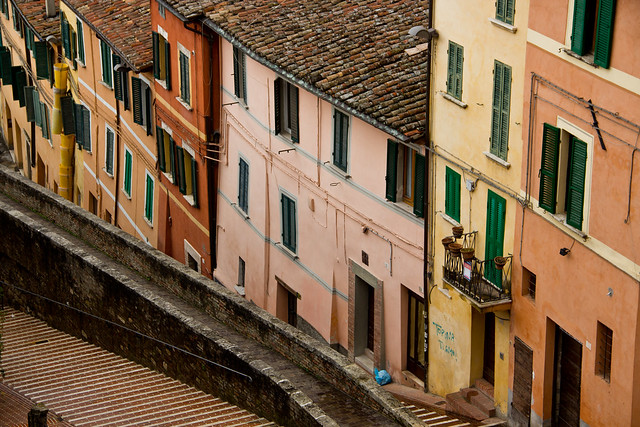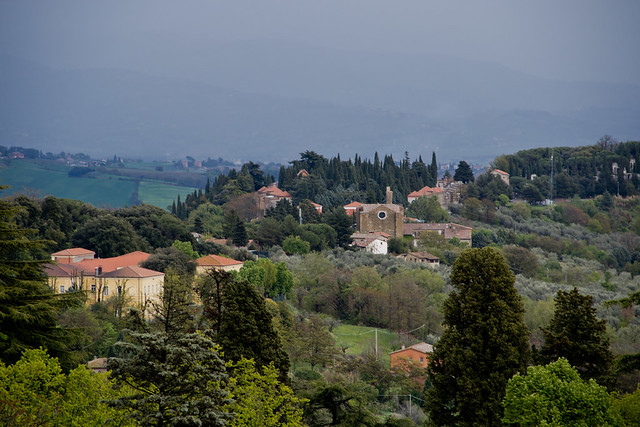Nestled atop a prominent hilltop in the heart of Umbria about two hours north of Rome, the medieval city of Perugia stands constant vigil over ancient trade routes. The current capital of the region, Perugia has a long and storied past that pre-dates the Romans and stretches back to the Etruscan period. With a population of just under 170,000 the city serves as home to a large university, and a plethora of wonderful festivals and events.
My visit to Perugia occurred as part of an afternoon photo workshop and walking tour with Ken Kaminesky as part of the Travel Bloggers Unite Umbria conference. Ken is a fantastic photographer with a specialty in HDR (High Dynamic Range Imaging). He was speaking at the conference and had offered to host one of the workshops which allowed a small group of us to pick his brain and discuss the simple (and not-so-simple) subtleties of advanced travel photography. After Ken’s initial presentation filled with great info, we piled onto a bus and were shuttled to the foot of Perugia. Once there we were greeted by the city’s futuristic mini-metro cable-driven cars which quickly ferried us up past ugly modern buildings and into the gorgeous heart of the old city. In a way, it felt as though we had boarded a time-ship and were pulled back hundreds of years in time.
We had parked and ascended on the side that was marked by modern structures – hotels, office buildings, and the types of structures you would expect. The first views as we exited the MiniMetro however, were breathtaking. The far side and the overlook were mostly natural and almost completely historic.
As we paused to gather our group together and lay out our plan of action I was immediately taken by the rich textures and colors of the surrounding buildings. Buildings that embody the very image of what I think of when I think “Italy”.
There’s something about the brick and earthen tile work on Perugia’s old buildings that really add to their character and charm. It gives them a mottled aged look, but in a way that still seems fresh, vibrant, and strong – only tempered with depth and added character.
One of the things I love about hilltop towns is the varied rooftop levels that result and the crazy quilt juxtaposition of building shapes. These can be gorgeous to behold. Hilltop towns offer the added depth of windows, portals, and views down partially obscured, winding streets. Each small alleyway begs exploration and beckons enticingly. There is mystery and magic unfolding in the twisting streets below. I pick out a few distinctive elements that I would later search out once I began my exploration of Perugia’s environs.
With more than 2,000 years of rich history and a far from insignificant role in Italy’s history, Perugia’s streets are decorated with small but historically interesting highlights. There are lots of features to photograph and enjoy.
As we wound in towards the city’s core Ken paused periodically to discuss framing, best conditions for lighting different shots, how to hunt for good people shots, and shared what he looks for when capturing a moment. Our path took us past the old palatial city hall before we paused in Piazza IV Novembre by the Fontana Maggiore.
I mentioned previously that the city is awash in wonderful textures. Those textures go far beyond the mottled reds and grays of the roof tiles on the city’s building’s. They permeate all aspects of the city, from the wonderful local Italian foods, deserts and famed candies to the marble decorations that highlight the walls of the local buildings.
It is only when you pause and look closely at the buildings that you start to realize just how old the city is! These buildings have stood for centuries and sustained a myriad of renovations and updates. Closer inspection reveals bricked in doorways, windows, arches, and building dividers. I find my eye is often drawn to the contrasting elements of modern plumbing and electrical lines attached to the surface of these ancient stones. All integrated into the crumbling (and oft repaired) brick walls that support foundations that have seen the passing of countless generations.
As we continued to cut across the crest of the hill we were soon met with by another wonderful overlook and a steep staircase that cut down into the small saddle where the majority of the city’s residential districts sit.
One thing that made me chuckle were all the satellite dishes. They serve as an interesting reminder that behind the facade of history and tradition lies a thriving, modern, 21st century city that is busy relaxing, working, and engaging with the rest of Italy and the world at large.
As we made our way down the staircase, our luck with the weather began to turn. We had driven through a light rain before arriving at Perugia. About 2/3 of the way through our walking workshop, the rain decided to make a light (but bearable) return. While we were all less than thrilled with the prospect of it turning into a more aggressive rain, it did serve to bring the colors out of all of the city’s stone and vegetation. It left sparkling water droplets on blades of grass and the city’s many flowers adding to their crisp and natural beauty.
The downside to exploring Italy’s incredible hilltop cities is, of course, that they’re actually on hills. Not just any hills – but usually quite steep ones. I can’t imagine what sort of adventure the streets turn into in the rare event that the towns get snow or rain-turned-ice. Regardless, it makes for wonderful curving streets that catch your eye and race with it down and away towards the flat plain below.
If you find yourself planning a trip to Umbria, definitely consider late April and early May. You avoid the conventional high season, the flowers are in bloom, and the air is fresh and crisp. It is just right for casual walking.
Just make sure to pack an umbrella and a sense of relaxed time. The weather in the region often seems to come in waves with a brief afternoon rain that quickly gives way to movie-perfect clouds and drifting skies. While animated, the Italian pace of life in these cities is often fairly relaxed and serves as a wonderful reminder to pause and enjoy the moment before setting aside an hour or two for an amazing meal.
Thanks again for Ken for the fantastic tips, TBU, Umbria on the Blog and the Umbrian Tourism Board for a great look at the city of Perugia.
These photos were shot on my new Canon T3i (600D)



